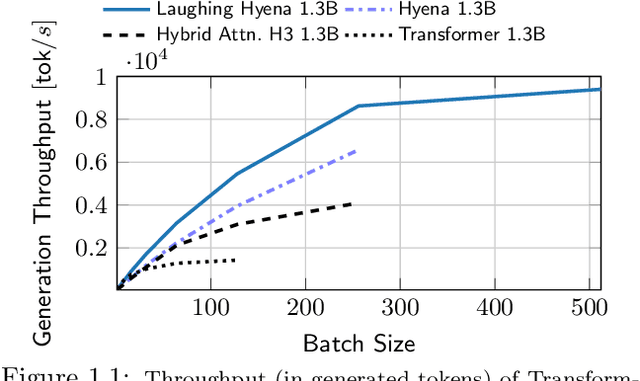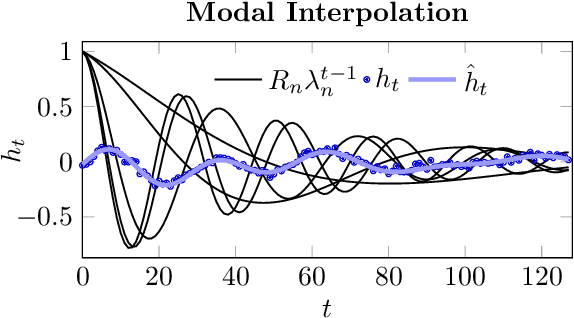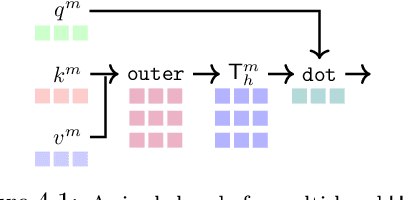Atri Rudra
Cartridges: Lightweight and general-purpose long context representations via self-study
Jun 06, 2025Abstract:Large language models are often used to answer queries grounded in large text corpora (e.g. codebases, legal documents, or chat histories) by placing the entire corpus in the context window and leveraging in-context learning (ICL). Although current models support contexts of 100K-1M tokens, this setup is costly to serve because the memory consumption of the KV cache scales with input length. We explore an alternative: training a smaller KV cache offline on each corpus. At inference time, we load this trained KV cache, which we call a Cartridge, and decode a response. Critically, the cost of training a Cartridge can be amortized across all the queries referencing the same corpus. However, we find that the naive approach of training the Cartridge with next-token prediction on the corpus is not competitive with ICL. Instead, we propose self-study, a training recipe in which we generate synthetic conversations about the corpus and train the Cartridge with a context-distillation objective. We find that Cartridges trained with self-study replicate the functionality of ICL, while being significantly cheaper to serve. On challenging long-context benchmarks, Cartridges trained with self-study match ICL performance while using 38.6x less memory and enabling 26.4x higher throughput. Self-study also extends the model's effective context length (e.g. from 128k to 484k tokens on MTOB) and surprisingly, leads to Cartridges that can be composed at inference time without retraining.
Towards Learning High-Precision Least Squares Algorithms with Sequence Models
Mar 15, 2025Abstract:This paper investigates whether sequence models can learn to perform numerical algorithms, e.g. gradient descent, on the fundamental problem of least squares. Our goal is to inherit two properties of standard algorithms from numerical analysis: (1) machine precision, i.e. we want to obtain solutions that are accurate to near floating point error, and (2) numerical generality, i.e. we want them to apply broadly across problem instances. We find that prior approaches using Transformers fail to meet these criteria, and identify limitations present in existing architectures and training procedures. First, we show that softmax Transformers struggle to perform high-precision multiplications, which prevents them from precisely learning numerical algorithms. Second, we identify an alternate class of architectures, comprised entirely of polynomials, that can efficiently represent high-precision gradient descent iterates. Finally, we investigate precision bottlenecks during training and address them via a high-precision training recipe that reduces stochastic gradient noise. Our recipe enables us to train two polynomial architectures, gated convolutions and linear attention, to perform gradient descent iterates on least squares problems. For the first time, we demonstrate the ability to train to near machine precision. Applied iteratively, our models obtain 100,000x lower MSE than standard Transformers trained end-to-end and they incur a 10,000x smaller generalization gap on out-of-distribution problems. We make progress towards end-to-end learning of numerical algorithms for least squares.
Just read twice: closing the recall gap for recurrent language models
Jul 07, 2024



Abstract:Recurrent large language models that compete with Transformers in language modeling perplexity are emerging at a rapid rate (e.g., Mamba, RWKV). Excitingly, these architectures use a constant amount of memory during inference. However, due to the limited memory, recurrent LMs cannot recall and use all the information in long contexts leading to brittle in-context learning (ICL) quality. A key challenge for efficient LMs is selecting what information to store versus discard. In this work, we observe the order in which information is shown to the LM impacts the selection difficulty. To formalize this, we show that the hardness of information recall reduces to the hardness of a problem called set disjointness (SD), a quintessential problem in communication complexity that requires a streaming algorithm (e.g., recurrent model) to decide whether inputted sets are disjoint. We empirically and theoretically show that the recurrent memory required to solve SD changes with set order, i.e., whether the smaller set appears first in-context. Our analysis suggests, to mitigate the reliance on data order, we can put information in the right order in-context or process prompts non-causally. Towards that end, we propose: (1) JRT-Prompt, where context gets repeated multiple times in the prompt, effectively showing the model all data orders. This gives $11.0 \pm 1.3$ points of improvement, averaged across $16$ recurrent LMs and the $6$ ICL tasks, with $11.9\times$ higher throughput than FlashAttention-2 for generation prefill (length $32$k, batch size $16$, NVidia H100). We then propose (2) JRT-RNN, which uses non-causal prefix-linear-attention to process prompts and provides $99\%$ of Transformer quality at $360$M params., $30$B tokens and $96\%$ at $1.3$B params., $50$B tokens on average across the tasks, with $19.2\times$ higher throughput for prefill than FA2.
Simple linear attention language models balance the recall-throughput tradeoff
Feb 28, 2024



Abstract:Recent work has shown that attention-based language models excel at recall, the ability to ground generations in tokens previously seen in context. However, the efficiency of attention-based models is bottle-necked during inference by the KV-cache's aggressive memory consumption. In this work, we explore whether we can improve language model efficiency (e.g. by reducing memory consumption) without compromising on recall. By applying experiments and theory to a broad set of architectures, we identify a key tradeoff between a model's state size and recall ability. We show that efficient alternatives to attention (e.g. H3, Mamba, RWKV) maintain a fixed-size recurrent state, but struggle at recall. We propose BASED a simple architecture combining linear and sliding window attention. By varying BASED window size and linear attention feature dimension, we can dial the state size and traverse the pareto frontier of the recall-memory tradeoff curve, recovering the full quality of attention on one end and the small state size of attention-alternatives on the other. We train language models up to 1.3b parameters and show that BASED matches the strongest sub-quadratic models (e.g. Mamba) in perplexity and outperforms them on real-world recall-intensive tasks by 6.22 accuracy points. Implementations of linear attention are often less efficient than optimized standard attention implementations. To make BASED competitive, we develop IO-aware algorithms that enable 24x higher throughput on language generation than FlashAttention-2, when generating 1024 tokens using 1.3b parameter models. Code for this work is provided at: https://github.com/HazyResearch/based.
Zoology: Measuring and Improving Recall in Efficient Language Models
Dec 08, 2023Abstract:Attention-free language models that combine gating and convolutions are growing in popularity due to their efficiency and increasingly competitive performance. To better understand these architectures, we pretrain a suite of 17 attention and "gated-convolution" language models, finding that SoTA gated-convolution architectures still underperform attention by up to 2.1 perplexity points on the Pile. In fine-grained analysis, we find 82% of the gap is explained by each model's ability to recall information that is previously mentioned in-context, e.g. "Hakuna Matata means no worries Hakuna Matata it means no" $\rightarrow$ "??". On this task, termed "associative recall", we find that attention outperforms gated-convolutions by a large margin: a 70M parameter attention model outperforms a 1.4 billion parameter gated-convolution model on associative recall. This is surprising because prior work shows gated convolutions can perfectly solve synthetic tests for AR capability. To close the gap between synthetics and real language, we develop a new formalization of the task called multi-query associative recall (MQAR) that better reflects actual language. We perform an empirical and theoretical study of MQAR that elucidates differences in the parameter-efficiency of attention and gated-convolution recall. Informed by our analysis, we evaluate simple convolution-attention hybrids and show that hybrids with input-dependent sparse attention patterns can close 97.4% of the gap to attention, while maintaining sub-quadratic scaling. Our code is accessible at: https://github.com/HazyResearch/zoology.
Laughing Hyena Distillery: Extracting Compact Recurrences From Convolutions
Oct 28, 2023



Abstract:Recent advances in attention-free sequence models rely on convolutions as alternatives to the attention operator at the core of Transformers. In particular, long convolution sequence models have achieved state-of-the-art performance in many domains, but incur a significant cost during auto-regressive inference workloads -- naively requiring a full pass (or caching of activations) over the input sequence for each generated token -- similarly to attention-based models. In this paper, we seek to enable $\mathcal O(1)$ compute and memory cost per token in any pre-trained long convolution architecture to reduce memory footprint and increase throughput during generation. Concretely, our methods consist in extracting low-dimensional linear state-space models from each convolution layer, building upon rational interpolation and model-order reduction techniques. We further introduce architectural improvements to convolution-based layers such as Hyena: by weight-tying the filters across channels into heads, we achieve higher pre-training quality and reduce the number of filters to be distilled. The resulting model achieves 10x higher throughput than Transformers and 1.5x higher than Hyena at 1.3B parameters, without any loss in quality after distillation.
Monarch Mixer: A Simple Sub-Quadratic GEMM-Based Architecture
Oct 18, 2023



Abstract:Machine learning models are increasingly being scaled in both sequence length and model dimension to reach longer contexts and better performance. However, existing architectures such as Transformers scale quadratically along both these axes. We ask: are there performant architectures that can scale sub-quadratically along sequence length and model dimension? We introduce Monarch Mixer (M2), a new architecture that uses the same sub-quadratic primitive along both sequence length and model dimension: Monarch matrices, a simple class of expressive structured matrices that captures many linear transforms, achieves high hardware efficiency on GPUs, and scales sub-quadratically. As a proof of concept, we explore the performance of M2 in three domains: non-causal BERT-style language modeling, ViT-style image classification, and causal GPT-style language modeling. For non-causal BERT-style modeling, M2 matches BERT-base and BERT-large in downstream GLUE quality with up to 27% fewer parameters, and achieves up to 9.1$\times$ higher throughput at sequence length 4K. On ImageNet, M2 outperforms ViT-b by 1% in accuracy, with only half the parameters. Causal GPT-style models introduce a technical challenge: enforcing causality via masking introduces a quadratic bottleneck. To alleviate this bottleneck, we develop a novel theoretical view of Monarch matrices based on multivariate polynomial evaluation and interpolation, which lets us parameterize M2 to be causal while remaining sub-quadratic. Using this parameterization, M2 matches GPT-style Transformers at 360M parameters in pretraining perplexity on The PILE--showing for the first time that it may be possible to match Transformer quality without attention or MLPs.
Simple Hardware-Efficient Long Convolutions for Sequence Modeling
Feb 13, 2023Abstract:State space models (SSMs) have high performance on long sequence modeling but require sophisticated initialization techniques and specialized implementations for high quality and runtime performance. We study whether a simple alternative can match SSMs in performance and efficiency: directly learning long convolutions over the sequence. We find that a key requirement to achieving high performance is keeping the convolution kernels smooth. We find that simple interventions--such as squashing the kernel weights--result in smooth kernels and recover SSM performance on a range of tasks including the long range arena, image classification, language modeling, and brain data modeling. Next, we develop FlashButterfly, an IO-aware algorithm to improve the runtime performance of long convolutions. FlashButterfly appeals to classic Butterfly decompositions of the convolution to reduce GPU memory IO and increase FLOP utilization. FlashButterfly speeds up convolutions by 2.2$\times$, and allows us to train on Path256, a challenging task with sequence length 64K, where we set state-of-the-art by 29.1 points while training 7.2$\times$ faster than prior work. Lastly, we introduce an extension to FlashButterfly that learns the coefficients of the Butterfly decomposition, increasing expressivity without increasing runtime. Using this extension, we outperform a Transformer on WikiText103 by 0.2 PPL with 30% fewer parameters.
Hungry Hungry Hippos: Towards Language Modeling with State Space Models
Dec 28, 2022Abstract:State space models (SSMs) have demonstrated state-of-the-art sequence modeling performance in some modalities, but underperform attention in language modeling. Moreover, despite scaling nearly linearly in sequence length instead of quadratically, SSMs are still slower than Transformers due to poor hardware utilization. In this paper, we make progress on understanding the expressivity gap between SSMs and attention in language modeling, and on reducing the hardware barrier between SSMs and attention. First, we use synthetic language modeling tasks to understand the gap between SSMs and attention. We find that existing SSMs struggle with two capabilities: recalling earlier tokens in the sequence and comparing tokens across the sequence. To understand the impact on language modeling, we propose a new SSM layer, H3, that is explicitly designed for these abilities. H3 matches attention on the synthetic languages and comes within 0.4 PPL of Transformers on OpenWebText. Furthermore, a hybrid 125M-parameter H3-attention model that retains two attention layers surprisingly outperforms Transformers on OpenWebText by 1.0 PPL. Next, to improve the efficiency of training SSMs on modern hardware, we propose FlashConv. FlashConv uses a fused block FFT algorithm to improve efficiency on sequences up to 8K, and introduces a novel state passing algorithm that exploits the recurrent properties of SSMs to scale to longer sequences. FlashConv yields 2$\times$ speedup on the long-range arena benchmark and allows hybrid language models to generate text 1.6$\times$ faster than Transformers. Using FlashConv, we scale hybrid H3-attention language models up to 1.3B parameters on the Pile and find promising initial results, achieving lower perplexity than Transformers and outperforming Transformers in zero- and few-shot learning on a majority of tasks in the SuperGLUE benchmark.
Arithmetic Circuits, Structured Matrices and (not so) Deep Learning
Jun 24, 2022



Abstract:This survey presents a necessarily incomplete (and biased) overview of results at the intersection of arithmetic circuit complexity, structured matrices and deep learning. Recently there has been some research activity in replacing unstructured weight matrices in neural networks by structured ones (with the aim of reducing the size of the corresponding deep learning models). Most of this work has been experimental and in this survey, we formalize the research question and show how a recent work that combines arithmetic circuit complexity, structured matrices and deep learning essentially answers this question. This survey is targeted at complexity theorists who might enjoy reading about how tools developed in arithmetic circuit complexity helped design (to the best of our knowledge) a new family of structured matrices, which in turn seem well-suited for applications in deep learning. However, we hope that folks primarily interested in deep learning would also appreciate the connections to complexity theory.
 Add to Chrome
Add to Chrome Add to Firefox
Add to Firefox Add to Edge
Add to Edge